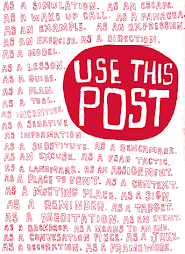http://www.upworthy.com/i-bet-
@rogre thanks. I thought @paultough needed to hear from the non - lunatic fringe
Original Tweet: https://twitter.com/irasocol/
Sent via TweetDeck
That fact: that quantifiable research can only tell you about what you already know, is a critical problem for people of Paul Tough's class, people with Data Over Acceptance Disorder. And its a disaster in education - block real change from ever being considered "What Works" by those in power. And so we get someone likeDavid Coleman, "architect of the Common Core," making this ridiculous - if entertainingly profane - statement:
"Do you know the two most popular forms of writing in the American high school today?…It is either the exposition of a personal opinion or the presentation of a personal matter. The only problem, forgive me for saying this so bluntly, the only problem with these two forms of writing is as you grow up in this world you realize people don’t really give a sh** about what you feel or think. What they instead care about is can you make an argument with evidence, is there something verifiable behind what you’re saying or what you think or feel that you can demonstrate to me. It is a rare working environment that someone says, “Johnson, I need a market analysis by Friday but before that I need a compelling account of your childhood.”
http://speedchange.blogspot.
..Data Over Acceptance Disorder, the problem of seeing the world purely through quantitative data analysis, combined with Elite Limited Vision Disorder, the belief that the world you know is the only world that matters. And if these are the disorders which limit and ultimately undo Tough's storytelling it is because not only the author suffers from these issues, but almost every adult interviewed in the book suffers from the same - from the unprepared Chicago High School principal to the founder of KIPP, from the University of Chicago economists who open Tough's tale to the pop psychologists who construct theories about "learned optimism."
Coleman, a life spent fully immersed in nothing but prior knowledge, cannot understand the power of either personal experience or the imagination. He believes that the best storytelling is that which is endlessly repeated until it is "normed." But the best storytelling is not what Paul Tough writes, or what David Coleman tests - rather - it begins with the art of seeing what few others can.
First, he tells us that kids in a Chicago juvenile detention facility have much smaller vocabularies than other students, but we have no way of knowing whether that is true or not. The vocabularies of the jailed teens was not measured, instead they were asked about white middle class vocabulary. I could easily devise a test based on South Side Chicago street vocabulary that middle class AP students would fail, but there just isn't any validity in either assessment.
Borderliners, in many ways what I consider the most important book available about education, is all about allostatic load, but it also understands that high allostatic load factors do not mean that a child comes to school "disadvantaged." Rather, their advantages are simply not respected nor exploited by the school. The damaged children described by the "young Peter's" narration are all brilliant, all incredible observers of their worlds, and are all incredibly capable.
And that makes all the difference in the world. Tough and friends want to teach "grit" to the "grittiest" kids in America, because none of them has any idea who these kids are.
Actually, what Tough and his friends want these kids to possess is willing compliance, not "grit" nor "character." "Grit" and "character," I have found in a lifetime of working with kids on that "borderline" Høeg talks about, is what has enabled the kids Tough wants to "help" to survive - even to age five or six.
@jonerichall What he says there resonates with this David Simon I've been obsessing about:http://t.co/5b2Vy0usbO + http://t.co/2qhRJyIIwG …
Original Tweet: https://twitter.com/rogre/
Original Tweet: https://twitter.com/rogre/
Loved this interview with Scott Dinsmore and Jonathan Fields. So many take aways.http://t.co/QF3zjgImOJ
Original Tweet: https://twitter.com/nickreese/
Original Tweet: https://twitter.com/nickreese/
http://blogs.edweek.org/
interesting.. at 9:52...
if you can't do the work you want to do - don't do it.
shouldn't that be for everyone?
Stopping Suicide | @scoopit http://t.co/CIhOs7AtWV
Original Tweet: https://twitter.com/
Original Tweet: https://twitter.com/
 jessicajackley (@jessicajackley) jessicajackley (@jessicajackley)12/12/13 6:48 AM What Kids Learn From Hearing Family Stories - Elaine Reese - The Atlanticbuff.ly/1iY9nw9 http://dark-mountain.net/blog/ http://www.nytimes.com/2013/ US drone strikes: winning hearts and minds one wedding massacre at a time http://t.co/yqKU77rC6b Original Tweet: https://twitter.com/ [ICYMI] 2013 Year in Review: 3 Top Posts That Define #CureViolence http://t.co/oBPhVTEwpv Original Tweet: https://twitter.com/ Cities r platforms 4 sharing & fountains 4 data! A little data abt many. Brilliant insights via @BradleyVoytek @PSFK http://t.co/RIsek21oIo Original Tweet: https://twitter.com/ http://www.detroitnews.com/ http://starthappy.fruit.com/ http://www.thestar.com/
Between 1955 and 1985, thousands of aboriginal children were taken from their homes by child welfare authorities without the consent of their parents. Under the cover of child protection, they were “adopted out” to white families or placed in nonindigenous foster homes. To ensure they never came back, death certificates were issued expunging any record of their aboriginal existence.
Beardy can’t say exactly how many children were scooped. No one knows. The Assembly of First Nations estimates 16,000 infants and children were uprooted. Some aboriginal groups put the number as high as 20,000.
|




































